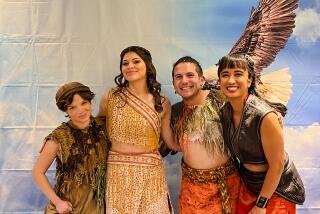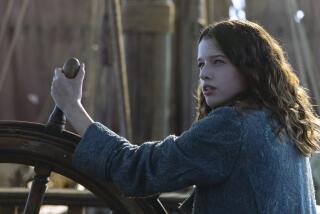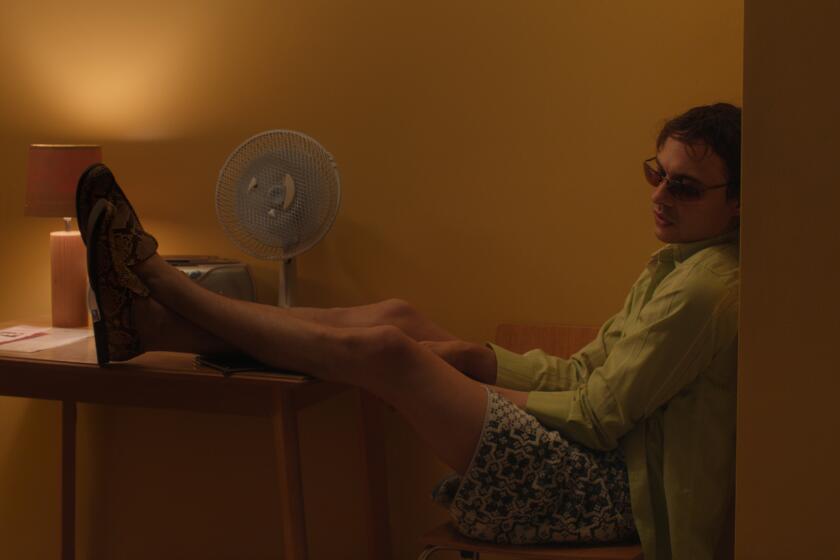The Real Peter Pan
- Share via
Throughout much of Stephen Spielberg’s new movie, “Hook,” my 12-year-old son and I found ourselves in the same state as the character played by Robin Williams: struggling to remember. At one point, having returned to Never-Never Land as a middle-aged adult, Spielberg’s Peter Banning (a.k.a. Peter Pan) finds himself in the now-ruined home of the Lost Boys and begins dimly to recall that Michael’s bed was over there and John’s was there. My son and I were agreeing with him but trying to recall whether that was the configuration in the Disney version or the one with Mary Martin.
Clocks are the real enemies in the story of Peter Pan. Growing up is something undesirable, if it means forgetting childhood and who you were. Maturity is like a ticking crocodile sneaking up to steal a part of you (if not your arm, then your memory), leaving you a maimed adult. So my son and I resolved that before we go see “Hook” again, we would remember and find out all we can. You can go to a video store, as we did, and rent the Disney and Mary Martin versions, and if you bother to find out more about J. M. Barrie and his story, this is what you’ll discover:
When he was a boy, Sir James Matthew Barrie (1860-1927) loved “penny dreadfuls” (the swashbuckling comic books of yesteryear), the novels of James Fenimore Cooper (with their Red Indians) and Ballantyne’s “The Coral Island” (a story of castaway boys that has inspired numerous other British works, from “Peter Pan” to “Lord of the Flies”). Barrie’s mother often told him about her late son David (who died when he was young and was therefore always 13 in her memory), and of losing her own mother early in life so that she was obliged, like Wendy, to become a girl-mother to her brother. Across from their home was a brick wash house where the young Barrie would stage impromptu theatricals and which was, he later said, the original inspiration for the home the Lost Boys built for Wendy.
In his 20s, Barrie moved to London, began to write, and befriended Robert Louis Stevenson (in whose “Treasure Island” appears Long John Silver, another pirate villain and amputee), and Kenneth Grahame (in whose “Wind and the Willows” appears Pan, the Roman god of nature). In London, Barrie also met and married Mary Ansell, a young actress.
It was an unhappy marriage, and there were rumors that it was never consummated (if you’re very progressive, explain this to your kids). In “Tommy and Grizel,” his thinly disguised autobiography, Barrie seems to offer an explanation: “He was a boy only. . . . Is it not cruel to ask a boy to love. . . . He was a boy who could not grow up.” In any event, Barrie and his wife were childless. She took consolation in raising dogs, Newfoundlands and St. Bernards; one of them would reappear as Nana, the rather unusual nursemaid of the Darling family. Barrie himself took consolation in befriending darling families.
It was Margaret, the daughter of editor W. E. Henley, who wanted to call the regular visitor to their house “my Friendy” but who mispronounced it and referred to Barrie as “my Wendy” (a name that did not exist before “Peter Pan”). But it was Barrie’s other long-term friendship, with the sons of Sylvia and Arthur Llewelyn Davies, that would really inspire him. As Andrew Birkin explains in “The Lost Boys,” his biography of Barrie, the Llewelyn Davies children would visit Barrie at his cottage in the countryside and play Indians and pirates with him on the lake, making each other walk the plank; and as Roger Lancelyn Green points out in “Fifty Years of Peter Pan,” all the male members of the fictional Darling family take their names from those boys.
“Peter Pan, or The Boy Who Wouldn’t Grow Up” opened on the London stage in 1904 and was a regular holiday offering until 1939; it also had a long run in the United States, from 1905 until 1924. Of course, there have been countless revivals--including a 1950 stage version in New York with music by Leonard Bernstein, the 1953 animated version by Disney Studios, the 1960 live presentation on NBC with Mary Martin, a 1982 revised theatrical in London, and now Spielberg’s “Hook.”
Spielberg’s film is interesting because it is an imagined sequel to “Peter Pan” and draws upon and makes reference to the long history of the story. At one point, to make Peter understand what has happened in the intervening years, Spielberg’s character is handed a copy of “Peter and Wendy”--Barrie’s later retelling of the play in book form, in which the author explained how Wendy grew up.
At the beginning of the film, an aged Wendy (played by Maggie Smith) is being honored for her philanthropic work with children; since 1929, royalties from “Peter Pan” have gone to the Great Ormond Street Children’s Hospital in London. Near the end, Robin Williams returns from Never-Never Land and wakes up in a London park at the base of a statue of Peter Pan; Barrie commissioned sculptor George Frampton to create that statue, and one night in 1912 had it secretly erected in Kensington Gardens, to give the impression it had arrived there by magic.
Spielberg’s film, in other words, has historical depth. In the Mary Martin version, for example, Cyril Ritchard played both Mr. Darling and Captain Hook. We might wonder what a child psychologist would say about that; in any event, this seems to explain the central dilemma in “Hook” when the villain steals away the children of Spielberg’s hero and claims to be their “real” father.
The story has changed in other ways: Instead of a girl (or in Mary Martin’s case, a woman), Peter Pan is played by a boy; and Tinkerbell, instead of being a bright light generated by a stage hand with a mirror, is fleshed out. The characterization of Tinkerbell, by the way, is said to have been the greatest problem faced by the Disney Studios; Walt himself settled the issue by saying she should look like Marilyn Monroe. Perhaps this explains Spielberg’s choice of Julia Roberts for the role.
When you know something about the story’s past, you’re left with interesting questions. Was Dustin Hoffman’s characterization of Captain Hook influenced by the fact that Boris Karloff and Charles Laughton also played the villain on the stage? Was Spielberg aware that in 1982 the Royal Shakespeare Company staged a considerably revised version of the play (with material added from Barrie’s life, “Peter and Wendy” and variant texts)? Were the screenwriters also inspired by Barrie’s last great theatrical success, “Dear Brutus,” where a few adults are given a second chance after their lives have taken a wrong turn? Did this lead them to create their own story about a yuppie so devoted to his career that he becomes a lousy parent, until he comes to his senses?
It may not be necessary to know all of this to enjoy either Barrie’s “Peter Pan” or Spielberg’s “Hook”; the story will always remain what Max Beerbohm found when he first saw the play: the tale of a “child in a state of nature unabashed--the child, as it were, in its bath, splashing and crowing as it splashes.” Still, when you go to the theater to visit Never-Never Land once again, it may be rewarding to know (as Spielberg makes clear) that you are traveling a well-worn path that others have traveled before. The directions, by the way, are unchanged: “Second star to the right and straight on till morning.”
More to Read
Only good movies
Get the Indie Focus newsletter, Mark Olsen's weekly guide to the world of cinema.
You may occasionally receive promotional content from the Los Angeles Times.










